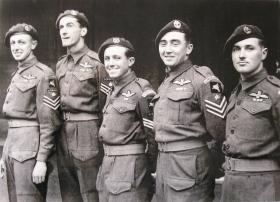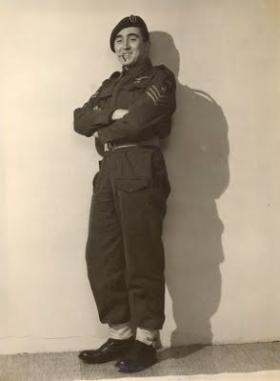James H ‘Jim’ Wallwork was born in Manchester, the son of an artilleryman who had served during the Great War. When Jim volunteered for the British Army in March 1939 his father advised him against joining the infantry. This advice was ignored although it was subsequently regretted and, despite being promoted to Sergeant, he tried to join the Royal Air Force. This was blocked by his Commanding Officer although in 1942 he was accepted for training in the newly formed Glider Pilot Regiment. By May 1942 he was at flight training school.
After completion of his flying training he was sent to North Africa where he took part in ‘Operation LADBROKE’, the mass glider assault by the 1st Airlanding Brigade to capture the Ponte Grande Bridge in Sicily on the 9-10 July 1943. Flying with Sergeant R Richards, they took off from Airfield ‘A’ in North Africa, with a platoon of the 2nd (Airborne) Battalion, The South Staffordshire Regiment on board and landed successfully on LZ ‘1’, which was 1 ½ miles south of the objective. He returned as one of the few glider pilots who had made it successfully to their LZ’s and objectives, to North Africa.
After a brief period of duties with the 1st Airborne Division in Italy from early September 1943, mainly concentrated around Taranto, he returned to the United Kingdom in time for the New Year of 1944. Here the Glider Pilot Regiment went through a re-organisation phase and Jim found himself in C-Squadron based at RAF Tarrant Rushton. The entire Regiment was involved in intense training for the invasion of Europe, but Jim and 3 other crews from C-Squadron were selected for a special mission. They were joined by 4 crews from B-Squadron.
Staff Sergeant Jim Wallwork set off on the evening of 5 June 1944, bound for LZ ‘X’ and what was to be the beginning of the invasion of Normandy. The Horsa glider that he flew (later known as Glider 1) was nicknamed ‘Lady Irene’ by Wally Parr, one of the gliders occupants from the 2nd Battalion The Ox & Bucks Light Infantry and landed in occupied France shortly after midnight. Their objective was the lifting bridge over the Caen canal at the small village of Benouville to the North of Caen. The force of the impact catapulted both Wallwork and his second pilot, John Ainsworth, through the front of the cockpit. Although stunned, this made them the first Allied troops to touch French soil on ‘D’-Day. Although suffering from the landing with the wounds to his head he managed to carry much needed ammunition boxes up to the troops defending the Caen Canal Bridge at Benouville, which was later named ‘Pegasus Bridge’ in honour of the 6th Airborne Division.
Read the account below for his personal description of the intense training programme prior to D-Day and the 'Pegasus Bridge' landings.
This remarkable achievement was described as "the greatest feat of flying of the second world war" by Air Chief Marshal Sir Trafford Leigh-Mallory. Although most famous for his part in the Battle of Normandy, Jim Wallwork flew gliders in two other major British airborne operation’s of the Second World War, Arnhem and the Rhine Crossings, one of only a very few pilots from the Glider Pilot Regiment to take part in all four major mass glider assaults.
After the war he worked as a salesman and then in 1956 he emigrated to British Columbia. He ran a small livestock farm to the East of Vancouver.
Profile photo supplied by Mike Peters
Further reading
An excellent linked web-site:www.britisharmedforces.org.
Compiled with assistance from Bob Hilton
Read More




Latest Comments
There are currently no comments for this content.
Add Comment
In order to add comments you must be registered with ParaData.
If you are currently a ParaData member please login.
If you are not currently a ParaData member but wish to get involved please register.